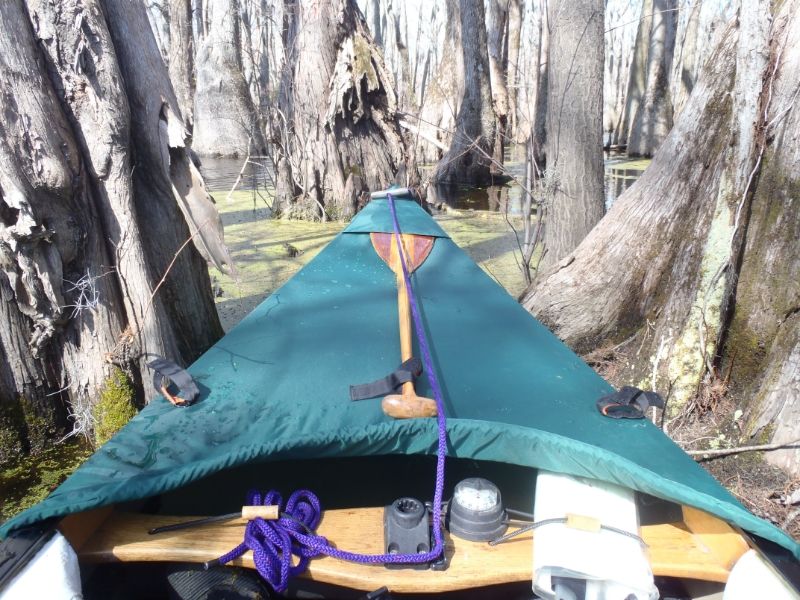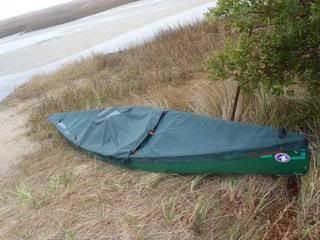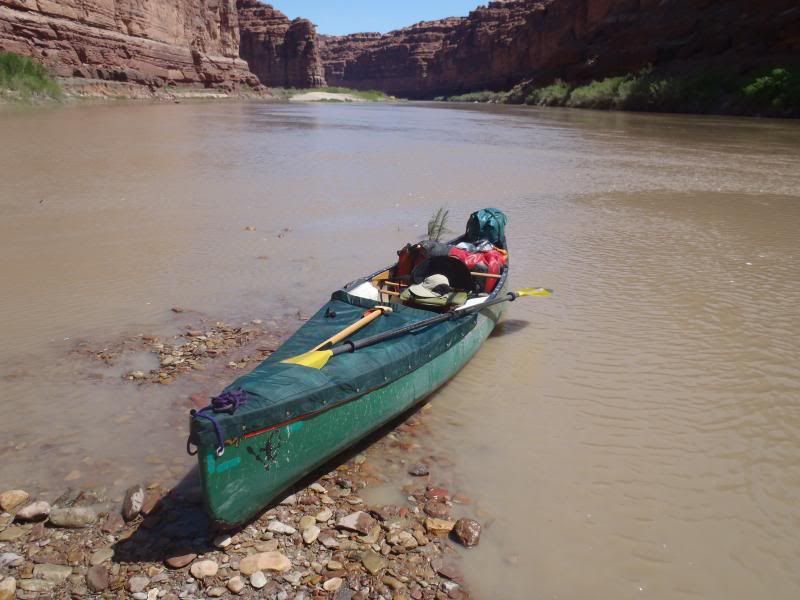G
Guest
Guest
Not done blabbing about decked canoes yet he said, grabbing a tape measure and wandering the racks.
Yellowcanoe mentioned the rocker on the Monarch. Looking at the decked canoes on the racks, except for the Sockeye they all have at least a couple inches of rocker at each end, some sterns a bit less. But that rocker is gentle and near continuous, stretched back 3 feet or more at either stem.
Having said all that, whadda I know - the ancient Sockeye, which is nearly the antithesis of every design element mentioned; deep stern stem, rocker near the stems and not elongated, etc is one of my favorite decked canoes. It is in many regards a more standard canoe hull shape with a deck, 16 feet 6 inches x 30 max beam, 14 ½” center depth at the top of the cockpit, short stem rocker and deeper than usual decked canoe ends.
And the Sockeye cockpit is generous, 21 x 81inside the coming, which makes entry/exit comfortably canoe familiar. The coming sides along cockpit need to be wide enough to deflect waves and spray, but the actual cockpit width makes a big difference to this big guy. The Sockeye and Monarch both have wide-ish cockpit openings, 21 ½ inches on the Monarch. Much the same for the Vagabond and Kamerad, both 20 ½ inches.
The Optima, which is otherwise a truly wonderful decked canoe, is only 18 inches wide between the cockpit coming sides. It is not canoe-like for entry/exit, and kind of a PITA at awkward landings, very much like getting in or out of a kayak. There’s a reason I don’t kayak; getting into/out of a 30 inch wide canoe is a lot different than getting into an 18 inch wide cockpit.
For my wide and unlimber load I wouldn’t want a cockpit less than 21 inches wide. If you are skinny and gymnastic YYMV.
The deck and side coming design may be the most interesting/challenging aspect. The hull waterline performance can be deduced from experience and existing designs, but mid-ships wave deflection of partial decks is more of a what-works-in-harmony crapshoot.
I do not understand that beyond observational experience. The Monarch and Optima are both flared out along the sides up to the high cockpit seam and do the best job of handing and absorbing side waves without bobble or splash. The Vagabond and Kamerad are both more slab sided and get pushed around more and fling more spray.
What else in terms of cockpit design? The Vagabond, despite being originally designed as a Tandem, is only 11 inches deep at center, which is too shallow in waves even as a day tripper solo and must have been awfully wet as a tandem. 11 inch deep is not enough when the waves kick up, even at a 220-280 lb burden. All of the others are in the 13 to 14 inch deep center range, and those couple extra inches make a huge difference when things get sloppy.
Cockpit length-wise all of the decks extend 5 feet +/- from the stems. As a personal preference I like having enough open space behind my seat for some easily accessible gear storage, even on day trips. For decked canoe tripping purposes having room for a blue barrel laid down lengthwise is huge boon; that being the only place available for barrel storage (or large dry bag/pack).
Last word on decked canoes. For today anyway J
A decked, unbulkheaded canoe is a PITA when swamped. OK, worse than a PITA, it is a long and arduous chore to empty. For day paddling use the more float bag you can secure under the stems the better. That under deck area is a weird shape for most standard canoe floatation; sometimes narrower dual split bags better fully occlude that under deck volume.
Please post as you progress with the design, build and trials. I will be very interested to follow along and hope to learn something.
My guess is that I'll modify my solo hull design by making it shorter, with more rocker, asymmetrical with a more full tail, and low decks. Once I paddle and play with it, I'll revisit adding a retractable skeg or rudder.
Ideally I'd have the time to make multiple hulls in order to experiment but that's just not going to happen anytime soon.
Yellowcanoe mentioned the rocker on the Monarch. Looking at the decked canoes on the racks, except for the Sockeye they all have at least a couple inches of rocker at each end, some sterns a bit less. But that rocker is gentle and near continuous, stretched back 3 feet or more at either stem.
Having said all that, whadda I know - the ancient Sockeye, which is nearly the antithesis of every design element mentioned; deep stern stem, rocker near the stems and not elongated, etc is one of my favorite decked canoes. It is in many regards a more standard canoe hull shape with a deck, 16 feet 6 inches x 30 max beam, 14 ½” center depth at the top of the cockpit, short stem rocker and deeper than usual decked canoe ends.
And the Sockeye cockpit is generous, 21 x 81inside the coming, which makes entry/exit comfortably canoe familiar. The coming sides along cockpit need to be wide enough to deflect waves and spray, but the actual cockpit width makes a big difference to this big guy. The Sockeye and Monarch both have wide-ish cockpit openings, 21 ½ inches on the Monarch. Much the same for the Vagabond and Kamerad, both 20 ½ inches.
The Optima, which is otherwise a truly wonderful decked canoe, is only 18 inches wide between the cockpit coming sides. It is not canoe-like for entry/exit, and kind of a PITA at awkward landings, very much like getting in or out of a kayak. There’s a reason I don’t kayak; getting into/out of a 30 inch wide canoe is a lot different than getting into an 18 inch wide cockpit.
For my wide and unlimber load I wouldn’t want a cockpit less than 21 inches wide. If you are skinny and gymnastic YYMV.
The deck and side coming design may be the most interesting/challenging aspect. The hull waterline performance can be deduced from experience and existing designs, but mid-ships wave deflection of partial decks is more of a what-works-in-harmony crapshoot.
I do not understand that beyond observational experience. The Monarch and Optima are both flared out along the sides up to the high cockpit seam and do the best job of handing and absorbing side waves without bobble or splash. The Vagabond and Kamerad are both more slab sided and get pushed around more and fling more spray.
What else in terms of cockpit design? The Vagabond, despite being originally designed as a Tandem, is only 11 inches deep at center, which is too shallow in waves even as a day tripper solo and must have been awfully wet as a tandem. 11 inch deep is not enough when the waves kick up, even at a 220-280 lb burden. All of the others are in the 13 to 14 inch deep center range, and those couple extra inches make a huge difference when things get sloppy.
Cockpit length-wise all of the decks extend 5 feet +/- from the stems. As a personal preference I like having enough open space behind my seat for some easily accessible gear storage, even on day trips. For decked canoe tripping purposes having room for a blue barrel laid down lengthwise is huge boon; that being the only place available for barrel storage (or large dry bag/pack).
Last word on decked canoes. For today anyway J
A decked, unbulkheaded canoe is a PITA when swamped. OK, worse than a PITA, it is a long and arduous chore to empty. For day paddling use the more float bag you can secure under the stems the better. That under deck area is a weird shape for most standard canoe floatation; sometimes narrower dual split bags better fully occlude that under deck volume.
Please post as you progress with the design, build and trials. I will be very interested to follow along and hope to learn something.



